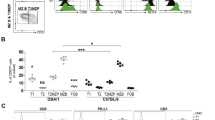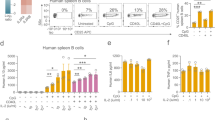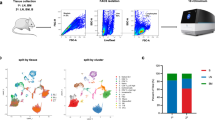Abstract
THYMUS-INDEPENDENT lymphocytes (B cells) comprise a heterogeneous population. Because of this heterogeneity, the precise nature of the signals which activate resting B cells to become antibody-forming cells is not known. It is likely that different subsets of B cells have different signalling requirements1–3. In addition, it has been proposed that B-cell proliferation and differentiation are controlled by separate and distinct signals4. Proliferation is thought to result from antigen binding with specific cell-surface immunoglobulin (Ig) receptors. However, due to the very low frequency of B cells reactive to a specific antigen, the activation process per se is difficult to study. This problem may be overcome by using reagents which mimic specific antigen binding to Ig receptors but act as polyclonal B-cell activators (PBAs). Anti-Ig antibodies are thought to function in this way and have been shown to be mitogenic for B cells5–7. Our laboratory has previously shown that soluble rabbit anti-mouse IgM or F(ab′)2 anti-IgM is mitogenic for mouse splenic B cells8,9. The response to intact anti-IgM only occurs with B cells from mice which are 7 months or older. In contrast, F(ab′)2 anti-IgM will stimulate B cells from both young and aged mice equally well suggesting that changes in B-cell Fc receptors may be involved in the age-dependent response to the intact anti-IgM molecule10. In all cases, the response requires cross-linkage of surface μ heavy chains and is T-cell independent10,11. In the present study, we have investigated the macrophage requirement for anti-Ig stimulation. The requirement for macrophages in B-cell activation by PBAs, including anti-Ig reagents, is controversial12,13. We report that the proliferative response of B cells to intact anti-IgM is macrophage dependent whereas the response of the same cell population to F(ab′)2 anti-IgM is macrophage independent.
This is a preview of subscription content, access via your institution
Access options
Subscribe to this journal
Receive 51 print issues and online access
$199.00 per year
only $3.90 per issue
Buy this article
- Purchase on Springer Link
- Instant access to full article PDF
Prices may be subject to local taxes which are calculated during checkout
Similar content being viewed by others
References
Lemke, H. et al. Scand. J. Immun. 4, 707–720 (1975).
Lewis, G. K., Ranken, R., Nitecki, D. E. & Goodman, J. M. J. Exp. Med. 144, 382–397 (1976).
Persson, U. C. I., Hammarström, L. L. G. & Smith, C. I. J. Immun. 119, 1138–1144 (1977).
Dutton, R. W. Transplant Rev. 23, 66–77 (1975).
Sell, S. & Gell, P. G. H. J. exp. Med. 122, 423–440 (1965).
Skamene, E. & Ivanyi, J. Nature 221, 681–682 (1969).
Gausset, P. et al. J. Immun. 116, 446–453 (1976).
Weiner, H. L., Moorhead, J. W. & Claman, H. N. J. Immun. 116, 1656–1661 (1976).
Weiner, H. L., Scribner, D. J. & Moorhead, J. W. J. Immun. 120, 1907–1912 (1978).
Scribner, D. J., Weiner, H. L. & Moorhead, J. W. J. Immun. 121, 377–382 (1978).
Weiner, H. L., Moorhead, J. W., Yamaga, K. & Kubo, R. T. J. Immun. 117, 1527–1531 (1976).
Persson, U. et al. Immun. Rev. 40, 78–101 (1978).
Diener, E. & Lee, K. C. in Progress in Immunology III (eds Mandel, T. E. et al.) 413–421 (Australian Academy of Science, 1977).
Sieckmann, D. G. et al. J. exp. Med. 148, 1628–1643 (1978).
Mongini, P., Friedman, S. & Wortis, H. Nature 276, 709–711 (1978).
Ly, I. A. & Mishell, R. J. immun. Meth. 5, 239–247 (1974).
Chen, C. & Hirsch, J. G. J. exp. Med. 136, 604–717 (1972).
Sidman, C. L. & Unanue, E. R. Proc. natn. Acad. Sci. U.S.A. 75, 2401–2405 (1978).
Parker, D. C. Nature 258, 361–363 (1975).
Schrier, R. D., Hattori, M. & Moorhead, J. W. J. Immun. (in the press).
Author information
Authors and Affiliations
Rights and permissions
About this article
Cite this article
HATTORI, M., SCRIBNER, D. & MOORHEAD, J. Macrophage requirements for mouse B-cell stimulation differ according to the molecular form of anti-IgM antibodies. Nature 280, 316–318 (1979). https://doi.org/10.1038/280316a0
Received:
Accepted:
Issue Date:
DOI: https://doi.org/10.1038/280316a0
Comments
By submitting a comment you agree to abide by our Terms and Community Guidelines. If you find something abusive or that does not comply with our terms or guidelines please flag it as inappropriate.



